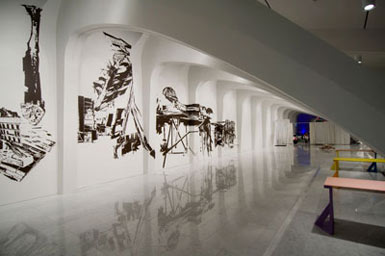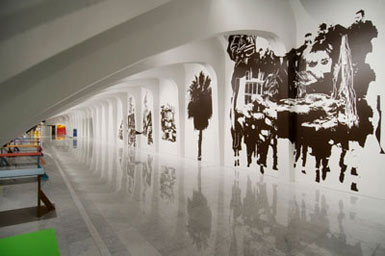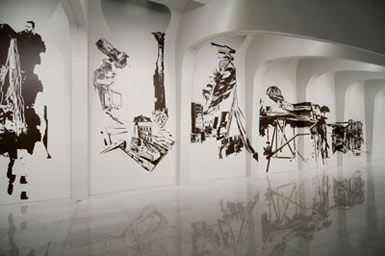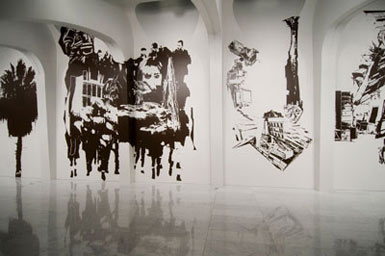
- Museum Home
- |
- Preview
- |
- Artist Bio
- |
- Process
- |
- Interview
- |
- Curator's Statement
ON SITE: SANTIAGO CUCULLU (MF Ziggurat)
April 24, 2008–January 4, 2009
Interview
Can you describe the process of imaging your work in this space?
Naturally, I wanted my work to overtake the ego implicit in Calatrava’s work and destroy the associations to him and the museum. My first thought was to literally pursue the goal of turning the hallway into an airport for a seaplane up to Sheboygan or some sort of transit center like a bus depot. I tried to think of the building’s west hallway as the opposite of what it was, or of how it could be upgraded.
Can you elaborate on how you view the Museum (and its architecture) in relationship to the city? How much did it affect your ideas about the exhibition?
After trying to consider the space more objectively, I decided to approach the space more conservatively, thinking of it as a sort of picture gallery, or a pedestal for a picture gallery. This idea of a pedestal may extend to the building itself in relation to the city. I thought of the aesthetics of the galleria, which I’ve thought of as a sort of art deco futurism. The aesthetics are a sort of art deco futurism—which I have an affinity towards—however, this aesthetic creates a specific context for work placed within it.
Then the process became one of tracing some of those aesthetic lines back to earlier examples of buildings in general, and the leverage of buildings within the structure of societies. This is what the title of the exhibition, MF Ziggurat, refers to—to that place where the remnants are dissolved and built onto a stratum. So, the hallway becomes a picture gallery, and the wall pieces serve the hallway as documents of an excavation. The video loops imply the world outside and the conductive nature of the space. Together these things act to heighten the nuances of Calatrava’s hallway in general. You know, how it sits among the loops and walls.
For this installation, you have adhered a mixture of imagery directly onto the walls much like you have done in past exhibitions. Can you describe this process and how it began?
The wall pieces are in a way very blasé, very dry in the specific role they take in the attempt to negate an object, per se. At least it was my thinking in graduate school when I started to make them. I was emulating Lilly van der Stokker and Lisa Ruyter, and for a short while, I thought this very negation could be transgressive. That the denial of an object was transgressive. That, of course, is incorrect, but it made me start thinking more about this particular attitude existing in sculpture, and its position in physical space, and sometimes materials. Looking back, there was a similarity towards my goals with the wall works. Specifically, something that is grounded in experience, a painting framed by a moment. Maybe abandoning the support inherent in painting allows a more tenuous nature to creep forward. This line of thinking invested a consideration in making other things very very flat.
Can you describe where you get the many different images for a wall drawing and how they come together for you?
The process begins by looking around at my immediate surroundings, whether my neighborhood or on my travels. The piece Ti vorei rivivere has references bound up in an extremely personal memory. I will quickly list the images that I have collaged together. The main sticks are from some sculptural studies I had installed in a studio in Japan that were later transformed into metal versions. These folding sculptures were inspired by some Lygia Clark pieces I had seen. They do not have a set form, and I keep using images of different versions of them in the wall pieces. Under them is a sort of figure-eight swoop. This is from some drawings I made in the snow using my bicycle. I kept looking for places where mine would be the first tracks in the fresh snow. At the top right is a tree from the Katsura Imperial Villa in Kyoto. I like that there is this general obfuscation of the thing itself in order to control an understanding or experience. As if knowing what something is directly changes an experience rather than us forming an understanding by ourselves. Also included are a traffic cone from a temple parking lot in Kyoto and a pumpkin left over from Halloween—in my opinion, an excellent event. Nothing specific in terms of how I want to “relive” this or that, but more of a reminiscence of these things, and then noticing that it is secret and I could not tell it if I wanted to. The final result is that I can make a piece and it becomes memory for someone else.
While you live in Milwaukee, you are often traveling to more exotic locations. Do these travels complicate your relationship to the city as home, or enhance it?
While other places in the world may seem more “exotic,” Millioke or “gathering place by the water,” is definitely in the running. The U.S. is as weird and alluring as anywhere. Slapstick and tragic within milliseconds of one another, with an amazingly creative nature at its core. But this can be equally destructive, and its cities reflect this.
Lately my work has been about home, in the most literal way to me that I can think about. I live here in Milwaukee largely because of circumstance, and it is circumstance that also drives some of my projects. In general for an artist, it seems that location can be inexorably linked toward the work he/she makes. Even though Milwaukee is a small town with only a couple of galleries or even non-profits I find interesting, there is a good community of working artists that I feel try to support one another. People like Paul Druecke, Steve Wetzel, Nick Frank, John and Joe Riepenhoff, the Reeder brothers, Annie Killelea, Kim Miller, Chris Smith, Bluemark productions, etc. Thankfully the list is truly long.
My friend suggested that sometimes there is a tendency for people to be too modest in their achievements, but in general, making art and being culturally proactive do not necessarily go hand in hand. That’s why we have a Favre and custard cult, and anti-abortionists that indulge in street theater almost every day. But you know, it’s home, and even though I live in my head a lot and often pine for B.A. [Buenos Aires], this is where I find myself, so I do my best to be a part of a community and to understand the place in general even though I sometimes feel strange here.
The works seem to be part of your experiences, whether moments captured by your video camera or stills from your digital camera. Can you describe how you use these tools to create your work?
I think that what I see functioning as “art” is not what most people value. Sometimes this leads me to second-guess myself, so for me, the camera becomes a quick tool towards an accumulated visual memory, while doubling as evidence of an existence and transience through a place. Also, I am a sloppy draughtsman and the camera frames things very neatly. It serves to order some parts of my thinking. In terms of making short video loops, I wanted to make something akin to a documentation of a fish tank. Something slapstick but heavily nuanced in an atmosphere. So far the loops: USA, Cafe Moves/Waver, Crab, Crocodile, Elvis St., Night Rider, Landing, Portuguese Lovers, etc., fall into the categories of place, people, or thing. And anyway, nothing ever actually happens that forms a narrative. After putting them in a DVD player, they just are (note Jan Christenson’s “no input” or “no disc” works), and function either until the disk loops reset or someone stops it. I don’t mean them to be sweet, cynical—even boring.
It’s not a strict categorization at all, but to me I hope they function like a 7-inch record, something inexpensive but with an intrinsic value or a non-plussed attitude. Something completely up to the viewer’s discretion. For the show, they are being shown on shelves or gangplanks. I would like them to function in support of the building, so in effect, they will be pointing out as well as in. There is still a negation, in that the sound is cut off when viewed from outdoors. Besides, the viewer’s position is mostly in passing, whether walking in the space or passing in a car.
How long does it take for you to process the images you have taken? Do you know what you want to do with them immediately, or do they take a while to solidify in your mind?
These days the object is not pinned down for the exhibition; until things are shown, they remain in flux. I am not opposed to cutting things that were planned or including last-minute pieces. It makes me uneasy to say the least, but besides the watercolors that I make, this constant shifting is part of the setups. I want the process of setting up the space to be as intuitive as possible. It’s often the best part.
The installation comprises many different elements of your artistic output. Do your ideas determine the media you work with, or do you develop the ideas after you have chosen your materials?
I am really clumsy with tools, so my means of communicating is simple—borrowing, stacking, and mixing unlike things together. I want a feeling of casualness even though that is hard to get to, as my nature is the opposite. So part of the process is pushing that uptight part away, discarding it. For example, the plank T.V. shelves. At first, I thought of them as white. Then I thought, ”May as well paint them,” so we picked the colors super fast. Then I became really anxious about the choice of colors (ridiculous, no?), but that led me to think...“What if the pieces get mixed up so that elements of the choice are within all the units rather than something more controlled and separate?”
What were the easiest and most difficult parts of the installation?
I liked making the loops the best (thanks to Chris, John R, and Bluemark); that, next to setting up the show, which is a little more intense and has yet to occur (crossing fingers).

On Site: Santiago Cucullu (MF Ziggurat)

On Site: Santiago Cucullu (MF Ziggurat)

On Site: Santiago Cucullu (MF Ziggurat)

On Site: Santiago Cucullu (MF Ziggurat)

